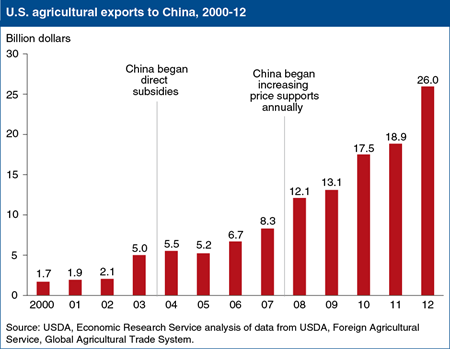Editor's Pick 2013: Best of Charts of Note
This chart gallery is a collection of the best Charts of Note from 2013. These charts were selected by ERS editors as those worthy of a second read because they provide context for the year’s headlines or share key insights from ERS research.

China has been an important source of recent growth in U.S. agricultural exports, and there has been concern about the implications of recent increases in China’s domestic farm support. While it is often presumed that subsidies and price supports give Chinese farmers an advantage, these policies actually may improve prospects for U.S. agricultural exports by raising costs and prices of Chinese commodities above international levels. As a World Trade Organization (WTO) member, China agreed to relatively low tariffs and eliminated most barriers to imports apart from tariff rate quotas for several types of cereal grains, cotton, and sugar. Consequently, as China raises domestic price supports above international prices, the country tends to attract more imports. As a result, China today is a net importer of the commodities that are the main targets of its domestic support programs—grains, oilseeds and cotton. This chart can be found in Growth and Evolution in China’s Agricultural Support Policies, ERR-153. Originally published on Tuesday, August 13, 2013.
_450px.png?v=6834.4)
China has been an important source of recent growth in U.S. agricultural exports, and there has been concern about the implications of recent increases in China?s domestic farm support. While it is often presumed that subsidies and price supports give Chinese farmers an advantage, these policies actually may improve prospects for U.S. agricultural exports by raising costs and prices of Chinese commodities above international levels. As a World Trade Organization (WTO) member, China agreed to relatively low tariffs and eliminated most barriers to imports apart from tariff rate quotas for several types of cereal grains, cotton, and sugar. Consequently, as China raises domestic price supports above international prices, the country tends to attract more imports. As a result, China today is a net importer of the commodities that are the main targets of its domestic support programs?grains, oilseeds and cotton. This chart can be found in Growth and Evolution in China?s Agricultural Support Policies, ERR-153. Originally published on Tuesday, August 13, 2013.

